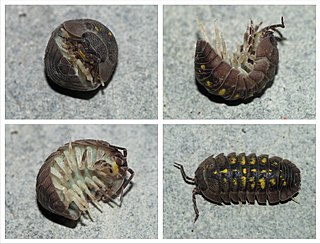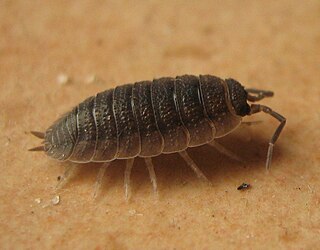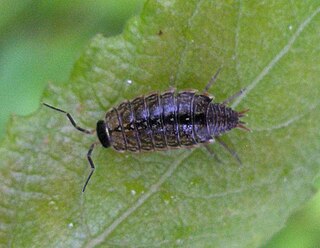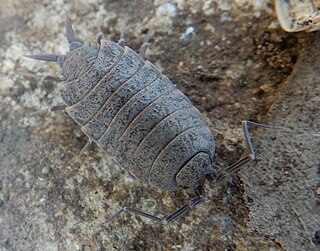
Armadillidium is a genus of the small terrestrial crustacean known as the woodlouse. Armadillidium are also commonly known as pill woodlice, leg pebbles, pill bugs, roly-poly, or potato bugs, and are often confused with pill millipedes such as Glomeris marginata. They are characterised by their ability to roll into a ball ("volvation") when disturbed.

Styloniscus is a genus of woodlice in the family Styloniscidae. It contains the following species as of 2010:

Porcellio is a genus of woodlice in the family Porcellionidae. These crustaceans are found essentially worldwide. A well-known species is the common rough woodlouse, Porcellio scaber.

Philosciidae are a family of woodlice. They occur almost everywhere on earth, with most species found in (sub)tropical America, Africa and Oceania, and only a few in the Holarctic.

Porcellionides is a genus of woodlice in the family Porcellionidae. It includes the following species :

Hemilepistus is a genus of woodlice, created by G. H. A. Budde-Lund in 1879 as a subgenus of Porcellio, but raised to the rank of genus by Karl Wilhelm Verhoeff in 1930. It contains the following species:

Platyarthridae is a family of woodlice, containing the following genera:

Trachelipus is a genus of woodlice in the family Trachelipodidae, containing the following species:

Armadillidae is a family of woodlice, comprising around 80 genera and 700 species. It is the largest family of Oniscidea, and one of the most species-rich families of the entire Isopoda. Armadillids generally have a strongly convex body shape, with some rather shallowly convex. Like members of the woodlice family Armadillidiidae, armadillids are capable of enrolling into a sphere (conglobation), and are commonly known as pill bugs. Armadillids differ from the Armadillidiidae in that the antennae are fully enclosed within the sphere.
Scleropactidae is a family of woodlice, with a predominantly Gondwanan distribution. It contains the following genera:
Niambia is a genus of woodlice in the family Platyarthridae. There are at least 20 described species in Niambia.
Rhyscotus is a genus of armadillo woodlice, land crustacean isopods of the family Rhyscotidae. It was first described in 1885 by Gustav Budde-Lund.

Tylos is a genus of woodlice in the family Tylidae. There are at least 20 described species in Tylos. All the species in this family can roll up into a perfect ball and live on sandy beaches.

Armadilloniscus is a genus of woodlice in the family Detonidae. There are more than 30 described species in Armadilloniscus.

Philoscia is a genus of woodlice in the family Philosciidae. There are more than 80 described species in Philoscia.

Eubelidae is a family of isopods belonging to the order Isopoda. It contains the following genera:













